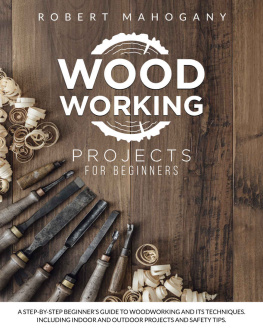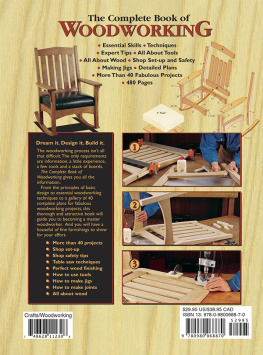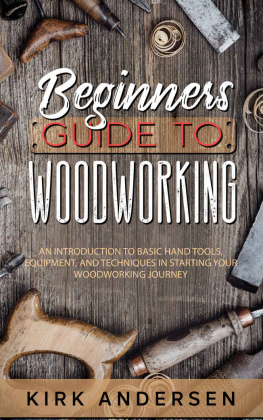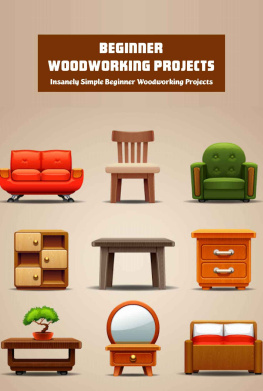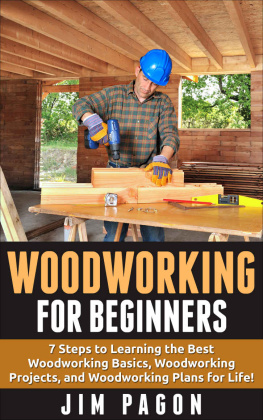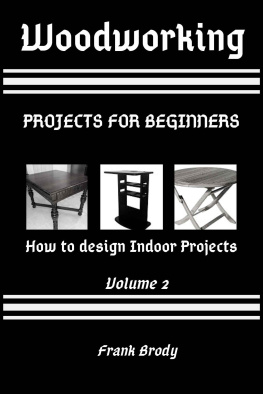Robert Mahogany - Woodworking Projects for Beginners: A Step-By-Step Beginners Guide To Woodworking and Its Techniques. Including Indoor and Outdoor Projects and Safety Tips
Here you can read online Robert Mahogany - Woodworking Projects for Beginners: A Step-By-Step Beginners Guide To Woodworking and Its Techniques. Including Indoor and Outdoor Projects and Safety Tips full text of the book (entire story) in english for free. Download pdf and epub, get meaning, cover and reviews about this ebook. year: 2021, genre: Children. Description of the work, (preface) as well as reviews are available. Best literature library LitArk.com created for fans of good reading and offers a wide selection of genres:
Romance novel
Science fiction
Adventure
Detective
Science
History
Home and family
Prose
Art
Politics
Computer
Non-fiction
Religion
Business
Children
Humor
Choose a favorite category and find really read worthwhile books. Enjoy immersion in the world of imagination, feel the emotions of the characters or learn something new for yourself, make an fascinating discovery.
- Book:Woodworking Projects for Beginners: A Step-By-Step Beginners Guide To Woodworking and Its Techniques. Including Indoor and Outdoor Projects and Safety Tips
- Author:
- Genre:
- Year:2021
- Rating:3 / 5
- Favourites:Add to favourites
- Your mark:
- 60
- 1
- 2
- 3
- 4
- 5
Woodworking Projects for Beginners: A Step-By-Step Beginners Guide To Woodworking and Its Techniques. Including Indoor and Outdoor Projects and Safety Tips: summary, description and annotation
We offer to read an annotation, description, summary or preface (depends on what the author of the book "Woodworking Projects for Beginners: A Step-By-Step Beginners Guide To Woodworking and Its Techniques. Including Indoor and Outdoor Projects and Safety Tips" wrote himself). If you haven't found the necessary information about the book — write in the comments, we will try to find it.
Robert Mahogany: author's other books
Who wrote Woodworking Projects for Beginners: A Step-By-Step Beginners Guide To Woodworking and Its Techniques. Including Indoor and Outdoor Projects and Safety Tips? Find out the surname, the name of the author of the book and a list of all author's works by series.
Woodworking Projects for Beginners: A Step-By-Step Beginners Guide To Woodworking and Its Techniques. Including Indoor and Outdoor Projects and Safety Tips — read online for free the complete book (whole text) full work
Below is the text of the book, divided by pages. System saving the place of the last page read, allows you to conveniently read the book "Woodworking Projects for Beginners: A Step-By-Step Beginners Guide To Woodworking and Its Techniques. Including Indoor and Outdoor Projects and Safety Tips" online for free, without having to search again every time where you left off. Put a bookmark, and you can go to the page where you finished reading at any time.
Font size:
Interval:
Bookmark:
WOODWORKING PROJECTS
FOR BEGINNERS
A Step-By-Step Beginners Guide to Woodworking and its techniques. including Indoor and Outdoor Projects and safety tips.
ROBERT MAHOGANY
Copyright 2020 - All rights reserved.
The content contained within this book may not be reproduced, duplicated or transmitted without direct written permission from the author or the publisher.
Under no circumstances will any blame or legal responsibility be held against the publisher, or author, for any damages, reparation, or monetary loss due to the information contained within this book. Either directly or indirectly.
Legal Notice: This book is copyright protected. This book is only for personal use. You cannot amend, distribute, sell, use, quote or paraphrase any part, or the content within this book, without the consent of the author or publisher.
Disclaimer Notice : Please note the information contained within this document is for educational and entertainment purposes only. All effort has been executed to present accurate, up to date, and reliable, complete information. No warranties of any kind are declared or implied. Readers acknowledge that the author is not engaging in the rendering of legal, financial, medical or professional advice. The content within this book has been derived from various sources. Please consult a licensed professional before attempting any techniques outlined in this book.
By reading this document, the reader agrees that under no circumstances is the author responsible for any losses, direct or indirect, which are incurred as a result of the use of information contained within this document, including, but not limited to, errors, omissions, or inaccuracies.
TABLE OF CONTENTS
W oodworking is not dangerous. It may be safer than driving. Understand how your tools work and how they can be used properly. Use common sense.
I believe that one of the reasons why woodwork has become a crazy popular hobby in recent years is that it provides people with a way back to all the noise that nowadays fills our lives. You're just when you step into a woodworking store to build something. You enter the shop with an idea of what you want to do and can find out how it will feel when you are finished. You can make something out of nothing using reasoning, intellect, ability to resolve challenges and common sense. You assume full responsibility for every part of a project from the preparation of a strategy or the construction of your instruments, the manufacture of wood and other materials, the commitment of a course of action, and the management of the problems you will use. It's a profitable operation.
Woodworking is enjoyable, and you get great things at home, but it's really about figuring out who we are and finding out that life can offer so many more intrinsic benefits when we take the time to make it. Put in some power tools for a few hours a week.
Woodworking has always played an important role in architecture, religion, agriculture, recreational activities, and survival.
Through improving woodworking skills, people have been able to hunt more effectively, establish tents, build boats, and promote life. Furniture, bowls, and spoons were made of wood and also rendered as sculpture. Woodworking contributed to social advancement.
While people continue to develop, woodworking has evolvedhumans have learned new skills and techniques and design principles, and woodworking is becoming an art. Like all arts, the woodwork was influenced by the cultures that surrounded it. Abstract wood carvings in ancient Thailand were essential parts of palaces and temples these carvings were often gold-colored to reflect natural light. Chinese and Japanese woodcarvers have creating decorations by considering them as art with lacquer and turning the decor into an art.
There were no beds at the beginning-I'm pretty sure early people either sat on the floor or even lifted fallen tree boughs and leaves to rest on when they slept. Furniture is now more than just sleeping and sitting for some, it is masterpieces of artworks or social statements. Yeah, how far we've come in this way just how far we've come.
Many people like a woodworking hobby because it's a relaxing place for their creativity. Woodwork is a great place to work for people who like their hands. Woodworking usually requires a great deal of emphasis on measurements and details. Since measurements and information are essential to the progress of a project, quality woodworking plans are needed.
Woodwork patterns are generally available, but not all are of the same quality. When it comes to selecting choices, purchasing them is not nearly as important as their size. The factor is the individual's level of competence. Plans that suit the hobbyist's level of skill should be used.
To order to use any woodworking plans successfully, you must be able to absorb what you know and fully understand what you are doing. A list of supplies to complete the project is one of the first items that the proposals will provide. It helps you plan so that you don't stop working on getting something that you didn't expect. Effective woodworking techniques also ensure you don't end up with many leftover tools. If you waste resources, you spend more on a job than you need.
The right woodworking strategies save time and money. You won't encounter unnecessary distractions or end up with such arrangements making costly mistakes. Any woodworking project will take time, but due to poor planning, it should not be permanent. Projects with very complex ideas, therefore, often end up more than anticipated.
Some project plans will have an extensive list of essential materials. Thanks to vague directions, there should never be an increase in the amount of content. Low-quality woodworking plans will frustrate an enjoyable project. For starters, it can be very frustrating if you buy additional materials because of mistakes created by the preparations not being known.
Successful woodworking techniques increase the efficiency of staff while reducing errors and money loss. That said, in decent woodworking plans, you can find certain distinctive features. A good plan describes the materials and equipment required to complete the project. You won't have the right tool or equipment until you start working without a simple set of plans. If that happens, you will find that you have invested more than you expected.
Although a detailed and correct list of materials is necessary, the recommendations are essential. The recommendations will explain precisely the steps involved. The preparations should be well planned and everything necessary established. The best plans contain pictures or illustrations according to the instructions. Woodworking designs should also include a snapshot of the project completed. This gives you a clear picture of how the vision will look.
In addition to pictures or maps, a list of measurements should provide specific information related to each step. A detailed list of dimensions means that every cut is made correctly. This is important because any measure that is even slightly inaccurate would kill the whole project. In this context, before beginning, it is essential to read the instructions carefully.
Woodworking plans are the main factor in any woodworking project. The plans can often lead to different successes and failures. The hobbyist must carefully read his or her chosen plans before each project starts so that he or she can grasp the direction before proceeding.
Go to teds woodwork ratings to discover the best ranking of the woodwork on the Internet.
Would you like a new hobby? Get some woodwork plans and try your hand on the craft!
A good number of woodworking schedules are just like an action plan for any job you've ever done. You will continue each project with a set of plans in the woodworking style. For any other idea, you will plan what you will do and how you will do it.
Font size:
Interval:
Bookmark:
Similar books «Woodworking Projects for Beginners: A Step-By-Step Beginners Guide To Woodworking and Its Techniques. Including Indoor and Outdoor Projects and Safety Tips»
Look at similar books to Woodworking Projects for Beginners: A Step-By-Step Beginners Guide To Woodworking and Its Techniques. Including Indoor and Outdoor Projects and Safety Tips. We have selected literature similar in name and meaning in the hope of providing readers with more options to find new, interesting, not yet read works.
Discussion, reviews of the book Woodworking Projects for Beginners: A Step-By-Step Beginners Guide To Woodworking and Its Techniques. Including Indoor and Outdoor Projects and Safety Tips and just readers' own opinions. Leave your comments, write what you think about the work, its meaning or the main characters. Specify what exactly you liked and what you didn't like, and why you think so.

